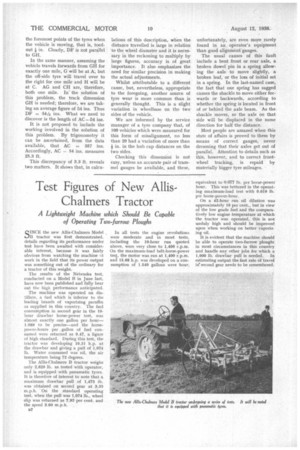Test Figures of New Allis Chalmers Tractor
Page 36

If you've noticed an error in this article please click here to report it so we can fix it.
A Lightweight Machine which Should Be Capable of Operating Two-furrow Ploughs
SINCE the new Allis-Chalmers Model B tractor was first demonstrated, details regarding its .performance under test have been awaited with considerable interest, because it was fairly obvious from watching the machine ftt work in the field that its power output was something out of the ordinary for a tractor of this weight.
The results of the Nebraska test, conducted on a Model 13 in June last, have now been published and fully bear out the high performance anticipated.
The machine was operated on distillate, a fuel which is inferior to the leading brands of vaporizing paraffin as supplied in this country. The fuel consumption in second gear in the 10hour drawbar horse-power test, was almost exactly one gallon per hour1.089 to be precise—and the horsepower-hours per .gallon of fuel consumed were returned as 9.47, a figure of high standard. During this test, the tractor was developing 10.31 h.p. at the drawbar and giving a pull of 1,074 lb. Water consumed was nil, the air temperature being 72 degrees.
The Allis-Chalmers B tractor weighs only 2.620 lb. as tested with operator, and is equipped with pneumatic tyres. It is therefore of interest to note that a maximum drawbar pull of 1,473 lb. was obtained on second gear at 3.30 m.p.h. On the standard operating test, when the pull was 1,074 lb.., wheel slip was returned as 7.92 per cent, and the speed 3.60 m.p.h.
n2
In all tests the engine revolutions were moderate and in most tests, including the 10-hour run quoted above, were very close to 1,400 r.p.m. On the maximum-load belt-horse-power test, the motor was run at 1,400 r.p.m. and 15.68 h.p. was developed on a consumption of 1.540 gallons were hour, equivalent to 0.677 lb. per horse-power hour. This was bettered in the operating maximum-load test with 0.619 lb. per horse-power-hour.
On a 42-hour run oil dilution was approximately 10 per cent., but in view of the low grade fuel and the comparatively low engine .temperature at which the tractor was operated, this is not unduly high and should be improved upon when working on better vaporiz. ing oil.
It is evident that the machine should be able to operate two-furrow ploughs in most circumstances in this country and handle any other jobs for which a
1,000 lb. drawbar pull is needed. In estimating output the fast rate of travel irisecond gear needs to be remembered.




















































































